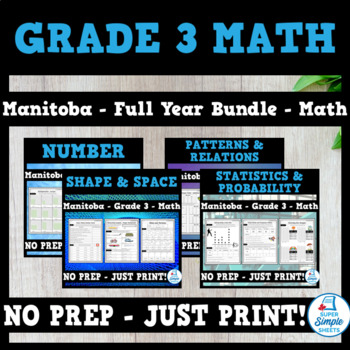Grade 3 - Manitoba Math - Full Year Bundle
Super Simple Sheets
12.7k Followers
Grade Levels
3rd
Subjects
Resource Type
Formats Included
- Zip
Pages
551 pages
Super Simple Sheets
12.7k Followers
What educators are saying
really like this bundle! the questions also mirror other grades, so it is easy to give this to my 3rd graders and use the 4th grade bundle for the grade 4's.
These packages were engaging and met all of the outcomes I needed to meet as a teacher! There were lots of strategies and adaptations in each booklet. I found this very helpful as a first year teacher!
Products in this Bundle (4)
Description
NO PREP - JUST PRINT! Grade 3 - Manitoba Math Curriculum Updated 2013 – This resource covers all expectations in the Grade 3 – Manitoba Math Curriculum. This product contains 551 activity sheets.
Check out each of the strands below to learn more about the resources included in this bundle.
Strand 1 - Number (Number Sense)
- Counting forwards and backwards by 3, 4, 5, 10, 25, and 100
- Representing and describing numbers to 1000
- Comparing and ordering numbers to 1000
- Estimating quantities less than 1000
- Rounding numbers less than 1000 to the nearest 10 and 100
- Understanding place value for numbers to 1000
- Using mental math addition strategies with two-digit numbers (counting on, making tens, doubling, adding using place value, and adding in chunks)
- Using mental math subtraction strategies with two-digit numbers (counting back, adding up, subtracting using place value, and subtracting in chunks)
- Round numbers and estimate the sums and differences of 2-digit numbers
- Add numbers up to 1000 using different strategies (no regrouping and regrouping activities)
- Subtract numbers up to 1000 using different strategies (no regrouping and regrouping activities)
- Solving adding and subtraction word problems
- Use mental math strategies to improve understanding of math facts up to 9 + 9
- Understanding multiplication and division facts up to 5 x 5 or 5 ÷ 5
- Solving multiplication and division problems using arrays
Strand 2 - Patterns and Relations
- Repeating Patterns (different shapes, sizes, colours, orientations)
- Creating increasing patterns (addition and multiplication)
- Extending increasing patterns (addition and multiplication)
- Comparing and describing increasing patterns
- Creating decreasing patterns (subtraction and division)
- Extending decreasing patterns (subtraction and division)
- Comparing and describing decreasing patterns
- Sorting objects and numbers using one or more than one attribute
- Solving addition equations by balancing equations
- Solving subtraction equations by balancing equations
- Determining the value or a variable in addition and subtraction equations
- Solving one-step addition and subtraction equations involving a symbol as the variable
- 2 Unit Tests – Patterning and Variables/Equations
Strand 3 - Shape and Space (3-D Objects and 2-D Shapes)
- Understanding time – minutes, hours, days, weeks, months, and years
- Use non-standard units for time
- Relating seconds to minutes, minutes to hours, hours to days, days to months, and months to years.
- Problem solving questions relating to time
- Measuring length and height using non-standard and standard units
- Using referents for measuring height and length
- Estimating length and height
- Understanding the relationship between cm and m
- Measuring the mass of objects using standard and non-standard units
- Estimating the mass of objects using referents
- Selecting a unit for measuring mass
- Understanding the relationship between grams and kilograms
- Finding perimeter of regular and irregular shapes
- Using metres and centimetres to find perimeter
- Constructing shapes using a known perimeter
- Describing 3-D objects based on the number of faces, edges and vertices
- Sorting 2-D shapes based on their sides (triangles, quadrilaterals, pentagons, hexagons, and octagons)
Strand 4 - Statistics and Probability
- Tally marks
- Line plots – creating and interpreting line plots
- Charts – creating and interpreting charts
- Lists – brainstorming lists and sorting data into lists
- Collecting data by creating and completing surveys
- Reading bar graphs
- Constructing bar graphs
- Using an appropriate scale when graphing
- Using vertical and horizontal bar graphs
- Labelling bar graphs
- Analyzing misleading bar graphs
- Comparing bar graphs with different scales but the same data
This is a comprehensive unit that will save you hours of planning! It has been tested and found effective in helping students achieve the specific learning outcomes created by Manitoba Education.
Follow Super Simple Sheets for more resources like this one!
Total Pages
551 pages
Answer Key
Included
Teaching Duration
N/A
Report this resource to TPT
Reported resources will be reviewed by our team. Report this resource to let us know if this resource violates TPT’s content guidelines.


